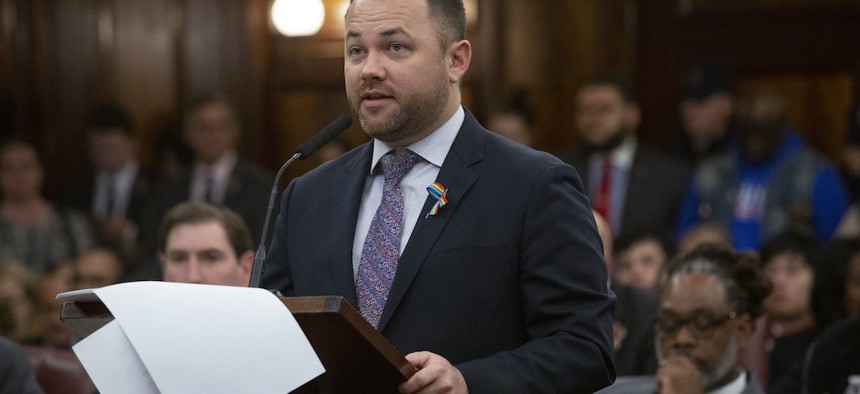New York City
By the numbers: New York City’s plan to close Rikers
It’s a major overhaul, here’s the breakdown in dollars and square feet.

New York City Council Speaker Corey Johnson delivering a passionate speech at City Hall in favor of closing the Rikers Island jail complex. John McCarten for the New York City Council
The proposal to close the Rikers Island jail complex and replace it with four new jails crossed a major threshold Thursday afternoon. In a contentious vote that could reshape how thousands of New Yorkers are locked up, the New York City Council approved the de Blasio administration’s plan to replace the facility with detention centers in several boroughs.
“For many of us this is one of the most significant votes of our entire career,” New York City Council Speaker Corey Johnson said in a fiery speech ahead of the vote at City Hall. “Rikers Island is a symbol of brutality and inhumanity.”
City Councilman Stephen Levin, whose district includes the site of the proposed Brooklyn jail, said the plan would get New York City “closer to full decarceration than any other city in the U.S.” Here’s how it all breaks down:
4: The number of new jails planned. One on the site of the Manhattan Detention Complex in Chinatown. One on the site of the Brooklyn Detention Complex in Downtown Brooklyn. One on the site of the shuttered Queens Detention Complex in Kew Gardens. And one on the site of the NYPD’s Bronx Tow Pound in Mott Haven.
36-13: The City Council’s vote total on the jails plan, with 36 in favor and 13 against, which counts as a close vote in the overwhelmingly Democratic Council. Two of the body’s 51 members weren’t in attendance.
10: The number of active jails expected to be permanently closed by the plan, including nine on Rikers Island, plus the Vernon C. Bain Center, also known as the Barge, in the Bronx. Jails in Brooklyn, Manhattan and Queens will be knocked down and rebuilt on site.
2026: The year the city plans to close Rikers and open the new jails. Responding to fears that future elected officials could derail the plan, the City Council passed a zoning map change that would prevent incarceration on the island after Dec. 31, 2026.
2: The driving distance in miles from the proposed Bronx jail site to Bronx Criminal Court – one of the factors that made it particularly controversial, since the others are connected to courthouses.
3,300: The estimated daily jail population in the city by 2026, compared to today’s 7,700 average. That’s due in large part to new state-level reforms such as limiting the use of cash bail.
$8.7 billion: That’s the city’s estimate for the total cost of building the new jails. Opponents of the plan often cited an $11 billion cost, adding $1.4 billion in operating costs and an extra $1 billion for cost overruns. and cost.
$265 million: How much the city is devoting as part of the plan to reducing incarceration through new investments like increasing pretrial supervised release and building new affordable housing near the jails.
295: The proposed height, in feet, of the new Brooklyn and Manhattan jails, or roughly 29 stories tall. The Queens and Bronx jails are both planned to be 195-feet tall.
1,156,900: The proposed square footage of the Queens jail, the largest of the four – a shade larger than the 1 million square-foot Woolworth Building in Lower Manhattan.
0 jails: The number of jails on Staten Island, now, and after the plan is implemented. The de Blasio administration said the cost would be too high to justify the relatively small population, but the expected ardent opposition from the community was probably also a factor.
44: Months since then-New York City Council Speaker Melissa Mark-Viverito endorsed closing Rikers Island, in Feb. 2016, setting Thursday’s vote in motion.

NEXT STORY: FCC approves T-Mobile-Sprint merger but AGs suit remains